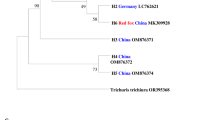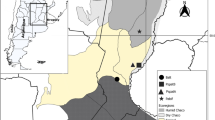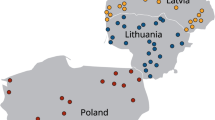Abstract
In this study, 36.8% (28/76) of tissue samples collected from domestic pigs (Sus scrofa) contained sarcocysts, as determined by light microscopy. The organisms were identified as Sarcocystis miescheriana and Sarcocystis suihominis based on their morphological and molecular characteristics. Four genetic markers, i.e., 18S rDNA, 28S rDNA, ITS-1 region (ITS-1), and the mitochondrial COX1 gene (COX1), of the two parasites were sequenced and analyzed, and the 28S rDNA and ITS-1 of S. suihominis obtained from pigs constituted the first records of these markers in GenBank. The sequences of the four loci (18S rDNA, 28S rDNA, ITS-1, and COX1) of S. miescheriana shared high identities with those of S. miescheriana obtained from domestic and/or wild pigs in GenBank, with similarities of 99.6%, 99.6%, 95.9%, and 95.4%, respectively. The 18S rDNA sequences of S. suihominis exhibited 99.4% identity with those of S. suihominis from domestic and wild pigs. The comparison of the newly obtained sequences of the four genetic markers between the two parasites revealed that the interspecific similarities of 18S rDNA, 28S rDNA, ITS-1, and COX1 were 97.7%, 96.6%, 80.3%, and 81.2%, respectively. Therefore, the two species could be better discriminated with ITS-1 and mitochondrial COX1 compared with 18S rDNA or 28S rDNA. The phylogenetic analysis using 28S rDNA indicated that the two Sarcocystis species in domestic pigs had a close relationship.


Similar content being viewed by others
References
Barrows PL, Prestwood AK, Green CE (1982) Experimental Sarcocystis suicanis infections: disease in growing pigs. Am J Vet Res 43:1409–1412
Dubey JP, Calero-Bernal R, Rosenthal BM, Speer CA, Fayer R (2016) Sarcocystosis of animals and humans, 2nd edn. CRC Press, Boca Raton
Fischer S, Odening K (1998) Characterization of bovine Sarcocystis species by analysis of their 18S ribosomal DNA sequences. J Parasitol 84:50–54
Gazzonis AL, Gjerde B, Villa L, Minazzi S, Zanzani SA, Riccaboni P, Sironi G, Manfredi MT (2019) Prevalence and molecular characterisation of Sarcocystis miescheriana and Sarcocystis suihominis in wild boars (Sus scrofa) in Italy. Parasitol Res 118:1271–1287. https://doi.org/10.1007/s00436-019-06249-2
Gjerde B (2013) Phylogenetic relationships among Sarcocystis species in cervids, cattle and sheep inferred from the mitochondrial cytochrome c oxidase subunit I gene. Int J Parasitol 43:579–591. https://doi.org/10.1016/j.ijpara.2013.02.004
Gjerde B (2014) Molecular characterisation of Sarcocystis rileyi from a common eider (Somateria mollissima) in Norway. Parasitol Res 113:3501–3509. https://doi.org/10.1007/s00436-014-4062-y
Gjerde B (2016) Molecular characterisation of Sarcocystis bovifelis, Sarcocystis bovini n. sp., Sarcocystis hirsuta and Sarcocystis cruzi from cattle (Bos taurus) and Sarcocystis sinensis from water buffaloes (Bubalus bubalis). Parasitol Res 115:1473–1492. https://doi.org/10.1007/s00436-015-4881-5
Heydorn AO (1977) Beiträge zum Lebenszyklus der Sarkosporidien. IX. Entwicklungszyklus von Sarcocystis suihominis n. spec. Berl Münch Tierärztl Wochenschr 90:218–224
Hu JJ, Meng Y, Chen XW, Zuo YX, Wu P (2010) Research progress on human sarcocystosis. Chin J Parasitol Dis 28:460–465
Hu JJ, Liu TT, Liu Q, Esch GW, Chen JQ, Huang S, Wen T (2016) Prevalence, morphology, and molecular characteristics of Sarcocystis spp. in domestic goats (Capra hircus) from Kunming, China. Parasitol Res 115:3973–3981. https://doi.org/10.1007/s00436-016-5163-6
Imre K, Sala C, Morar A, Imre M, Ciontu C, Chisăliță I, Dudu A, Matei M, Dărăbuș G (2017) Occurrence and first molecular characterization of Sarcocystis spp. in wild boars (Sus scrofa) and domestic pigs (Sus scrofa domesticus) in Romania: public health significance of the isolates. Acta Trop 167:191–195. https://doi.org/10.1016/j.actatropica.2016.12.038
Kaur M, Singh BB, Sharma R, Gill JP (2016) Pervasive environmental contamination with human feces results in high prevalence of zoonotic Sarcocystis infection in pigs in the Punjab, India. J Parasitol 102:229–232. https://doi.org/10.1645/15-828
Kia EB, Mirhendi H, Rezaeian M, Zahabiun F, Sharbatkhori M (2011) First molecular identification of Sarcocystis miescheriana (Protozoa, Apicomplexa) from wild boar (Sus scrofa) in Iran. Exp Parasitol 127:724–726. https://doi.org/10.1016/j.exppara.2010.11.007
Kumar S, Stecher G, Tamura K (2016) MEGA7: Molecular evolutionary genetics analysis version 7.0 for bigger data sets. Mol Biol Evol 33:1870–1874
Li YM, Lian ZQ (1986) Studies on man-pig cyclic infection of Sarcocystis suihominis found in Yunnan Province, China. Acta Zool Sin 32:329–334
Medlin L, Elwood HJ, Stickel S, Sogin ML (1988) The characterization of enzymatically eukaryotic 16S-like rRNA-coding regions. Gene 71:491–499
Mugridge NB, Morrison DA, Heckeroth AR, Johnson AM, Tenter AM (1999) Phylogenetic analysis based on full-length large subunit ribosomal RNA gene sequence comparison reveals that Neospora caninum is more closely related to Hammondia heydorni than to Toxoplasma gondii. Int J Parasitol 29:1545–1556
Yan W, Qian W, Li X, Wang T, Ding K, Huang T (2013) Morphological and molecular characterization of Sarcocystis miescheriana from pigs in the central region of China. Parasitol Res 112:975–980. https://doi.org/10.1007/s00436-012-3219-9
Funding
This work was supported by the National Key R&D Program of China (grant 2017YFD0500400), the Natural Sciences Foundation of China (grant 31460557), and the Southeast Asia Biodiversity Research Institute, Chinese Academy of Science (grant Y4zk111B01).
Author information
Authors and Affiliations
Corresponding authors
Ethics declarations
Conflict of interest
The authors declare that they have no conflict of interest.
Additional information
Section editor: Daniel K. Howe
Publisher’s note
Springer Nature remains neutral with regard to jurisdictional claims in published maps and institutional affiliations.
Rights and permissions
About this article
Cite this article
Huang, Z., Ye, Y., Zhang, H. et al. Morphological and molecular characterizations of Sarcocystis miescheriana and Sarcocystis suihominis in domestic pigs (Sus scrofa) in China. Parasitol Res 118, 3491–3496 (2019). https://doi.org/10.1007/s00436-019-06521-5
Received:
Accepted:
Published:
Issue Date:
DOI: https://doi.org/10.1007/s00436-019-06521-5




